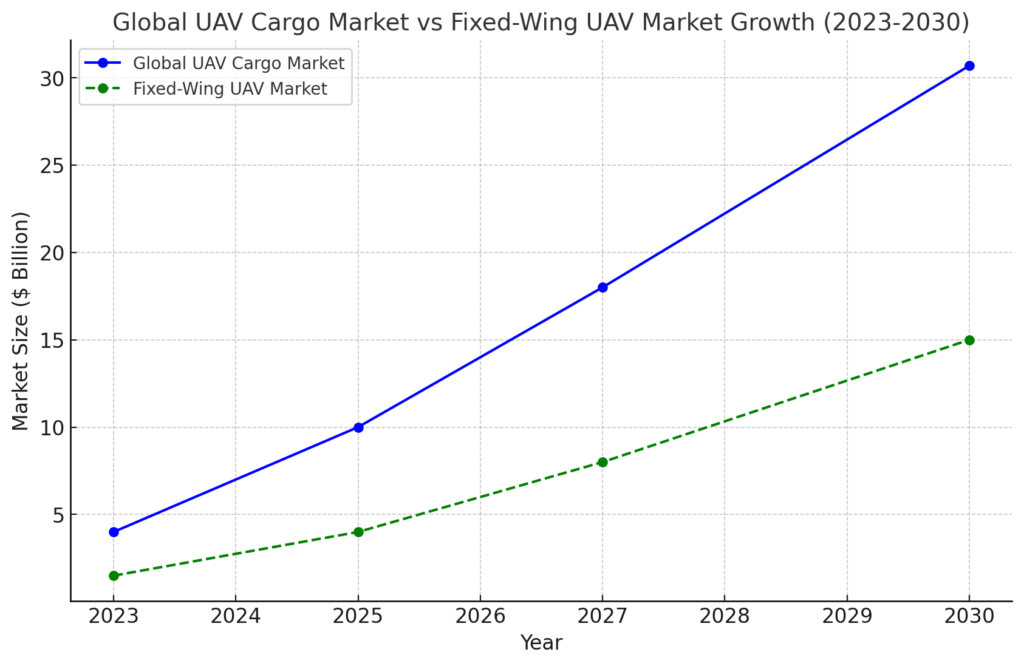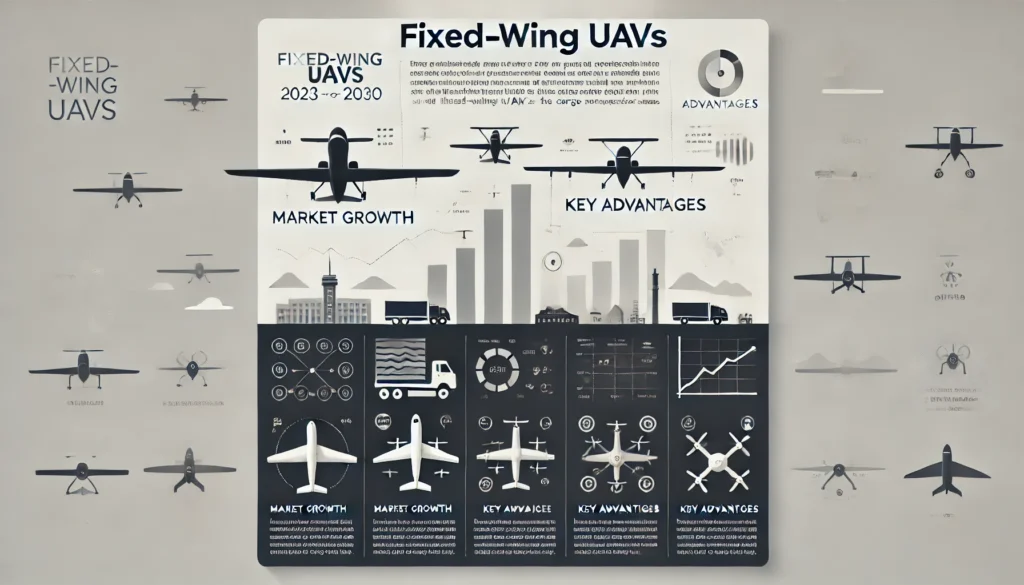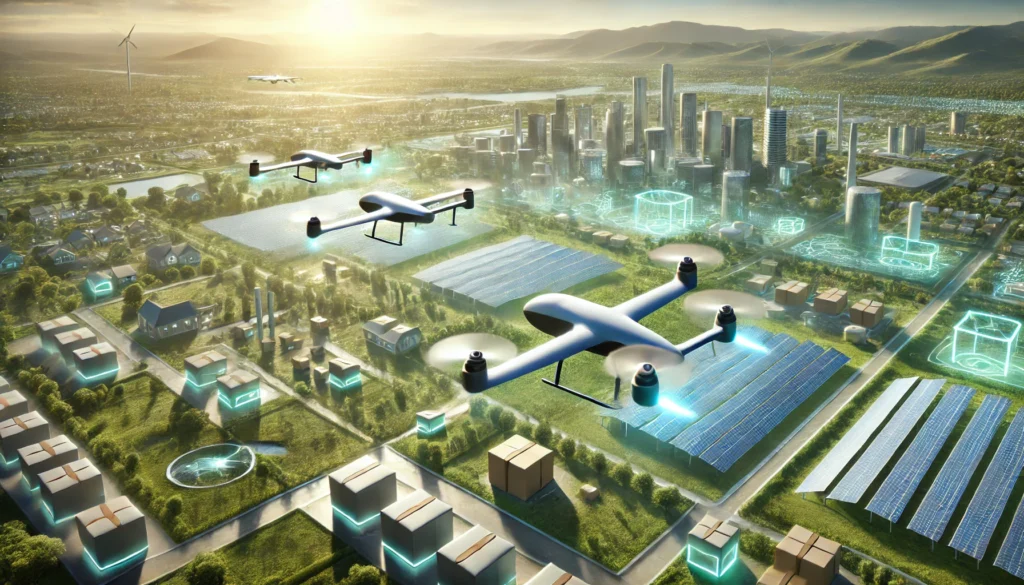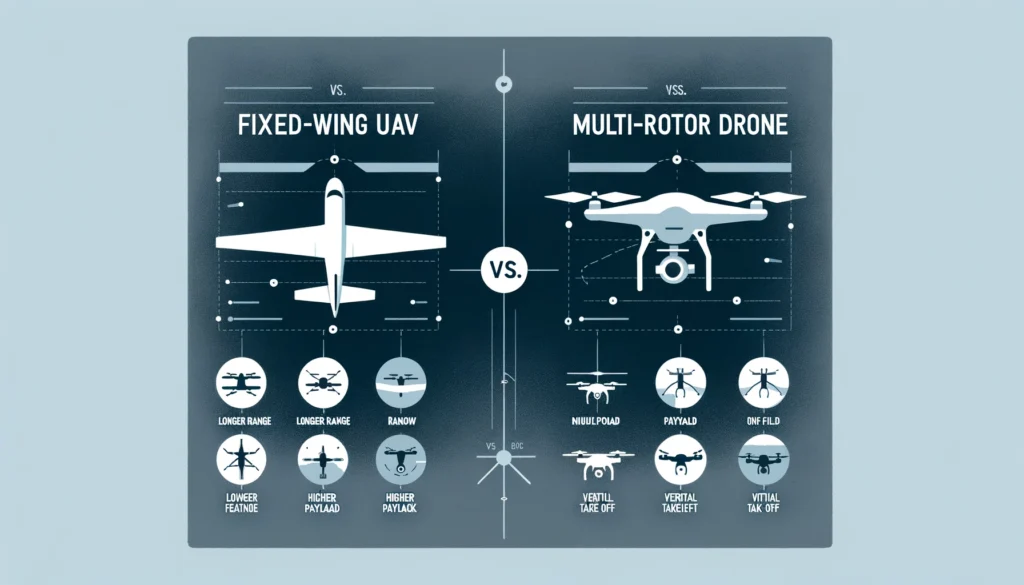Executive Summary
The fixed-wing cargo UAV (Unmanned Aerial Vehicle) market is on the brink of explosive growth, driven by technological advancements, the increasing demand for efficient logistics solutions, and the need to access remote areas across various industries. Valued at $4 billion in 2023, the UAV cargo market is projected to expand at a robust Compound Annual Growth Rate (CAGR) of 23.4%, reaching $30.69 billion by 2030. Fixed-wing UAVs, in particular, are emerging as crucial assets in middle-mile and long-range logistics due to their superior range, speed, and payload capacity compared to rotary-wing drones.
This report outlines the substantial long-term growth potential of investing in fixed-wing cargo UAVs, supported by trends in logistics, healthcare, e-commerce, industrial applications, and disaster relief. We will explore key market drivers, the competitive landscape, technological innovations, regulatory challenges, and potential returns on investment.
1. Market Overview
The fixed-wing cargo UAV market is experiencing a surge in demand across multiple sectors, owing to the significant advantages these UAVs offer over traditional logistics methods and rotary-wing drones.
1.1 Market Size and Growth Projections
- 2023: The global UAV cargo market is valued at $4 billion, with fixed-wing UAVs contributing $1.5 billion.
- 2030: The market is expected to grow to $30.69 billion, with fixed-wing UAVs projected to capture $15 billion of the total market, driven by the need for efficient and fast middle-mile logistics.
- Growth Rate: The CAGR of 23.4% for the UAV cargo market surpasses many other sectors, such as electric vehicles (EVs) and artificial intelligence (AI), which are growing at similar rates due to technological innovation and shifting consumer needs.

1.2 Key Market Drivers
- E-commerce Growth: The rise in global e-commerce and the increasing demand for faster deliveries are key growth drivers. Fixed-wing UAVs enable rapid transportation between distribution centers, significantly reducing delivery times.
- Healthcare Logistics: UAVs are critical for delivering medical supplies, vaccines, and emergency equipment to remote or underserved regions, particularly in healthcare and disaster relief scenarios.
- Cost Efficiency: Fixed-wing UAVs offer substantial savings in operating costs compared to trucks and traditional air transport, reducing fuel and labor expenses, especially for middle-mile logistics.
- Sustainability: UAVs provide a greener alternative to traditional logistics, helping companies meet environmental sustainability goals by reducing carbon emissions in transportation.
2. Technological Advantages of Fixed-Wing UAVs
Fixed-wing UAVs offer several technological advantages over rotary-wing drones and traditional transport methods, making them the ideal solution for medium- to long-range cargo delivery.
2.1 Range and Speed
- Extended Range: Fixed-wing UAVs can travel significantly further than rotary-wing drones, making them more suitable for inter-city and regional logistics. Some models offer ranges up to 1,000 km, far exceeding the typical capabilities of rotary drones.
- Higher Speeds: Fixed-wing UAVs can operate at speeds between 150-250 km/h, reducing delivery times significantly compared to ground-based transportation. This is particularly beneficial for industries that rely on time-sensitive deliveries, such as healthcare and just-in-time (JIT) manufacturing.
2.2 Payload Capacity
- Larger Payloads: Fixed-wing UAVs can carry heavier loads than their rotary counterparts, with some models capable of handling payloads of up to 500 kg. This increased capacity makes them suitable for transporting industrial goods, medical supplies, and e-commerce shipments over longer distances.
- Modular Payload Options: Fixed-wing UAVs often feature modular systems that allow for flexible cargo configurations, enabling industries to optimize their loads for various types of goods, including perishables, medical supplies, and industrial parts.
2.3 Autonomy and AI Integration
- Advanced Navigation Systems: Fixed-wing UAVs are equipped with sophisticated autonomous navigation systems powered by AI, which optimize flight paths, avoid obstacles, and ensure efficient delivery. These autonomous systems reduce labor costs by eliminating the need for pilots.
- Precision and Reliability: AI and machine learning technologies allow UAVs to make real-time decisions, ensuring safe and reliable operations even in challenging environments such as disaster zones or remote regions with limited infrastructure.
3. Market Applications and Sectors Benefiting from UAV Cargo
3.1 E-commerce and Retail Logistics
E-commerce companies such as Amazon and JD.com are heavily investing in UAV technology to meet growing customer demand for fast and reliable deliveries. Fixed-wing UAVs offer significant benefits in middle-mile logistics, connecting regional hubs and distribution centers. This allows companies to reduce delivery times and cut costs, especially in regions with challenging terrain or inadequate road infrastructure.
3.2 Healthcare and Medical Logistics
Fixed-wing UAVs are already being used in regions like Africa to deliver life-saving medical supplies to remote areas. Companies such as Zipline have pioneered the use of drones for healthcare deliveries, providing critical support in delivering vaccines, blood products, and emergency medical equipment. The healthcare sector stands to benefit enormously from UAVs, particularly in:
- Emergency Deliveries: UAVs can quickly transport medical supplies to disaster-stricken areas where traditional logistics are impeded.
- Remote Area Access: Fixed-wing UAVs can deliver supplies to regions with poor infrastructure, ensuring that healthcare providers receive the equipment they need on time.
3.3 Industrial and Manufacturing Supply Chains
In sectors like automotive manufacturing, aerospace, and heavy machinery, where JIT delivery systems are critical, fixed-wing UAVs ensure that necessary parts and materials arrive faster, reducing production downtime. Industries relying on complex global supply chains can integrate UAVs into their operations to:
- Avoid Supply Chain Bottlenecks: Fixed-wing UAVs can bypass congested roads or inaccessible areas, keeping supply chains running smoothly.
- Enhance Just-in-Time Manufacturing: Speedy delivery of components ensures manufacturing processes are not disrupted by delayed shipments, leading to improved operational efficiency.
3.4 Disaster Relief and Emergency Response
Fixed-wing UAVs are essential for delivering food, water, and medical supplies to areas affected by natural disasters, where road infrastructure may be damaged or inaccessible. UAVs are faster, more flexible, and more reliable than traditional trucks in these situations. They have already been deployed in areas hit by floods, earthquakes, and wildfires, demonstrating their effectiveness in emergency logistics.
3.5 Remote and Rural Deliveries
In geographically challenging regions, such as islands, mountains, or coastal areas, fixed-wing UAVs provide a solution for regular deliveries where trucks and ships are inefficient. For example:
- Island Deliveries: Fixed-wing UAVs can fly directly to island destinations, eliminating the need for ferry coordination.
- Mountainous Terrain: UAVs bypass the need for trucks to navigate difficult roads, ensuring timely deliveries regardless of weather or road conditions.
4. Competitive Landscape
The fixed-wing cargo UAV market is populated by innovative companies that are leading the way in developing cutting-edge solutions for logistics and healthcare. Key players include:
- Zipline: A pioneer in medical supply delivery using fixed-wing UAVs, Zipline has established operations in Africa and is expanding globally.
- Wing (Alphabet): Wing, a subsidiary of Alphabet, focuses on developing long-range UAV systems for logistics and suburban deliveries.
- Amazon Prime Air: Amazon is exploring the use of fixed-wing UAVs for middle-mile logistics, particularly for deliveries to regional hubs.
- Matternet: Specializing in last-mile delivery for healthcare, Matternet’s fixed-wing UAVs are widely used in hospitals and medical facilities for transporting medical samples and urgent supplies.
These companies are capitalizing on the growing demand for faster, more efficient cargo solutions and are setting the stage for further innovation in the UAV cargo space.
5. Regulatory and Infrastructure Challenges
5.1 Regulatory Barriers
One of the major challenges facing the widespread adoption of fixed-wing UAVs is the regulatory framework governing UAV flights. In many countries, regulations around Beyond Visual Line of Sight (BVLOS) operations are still being developed. For fixed-wing UAVs to reach their full potential, regulatory bodies such as the FAA (U.S.) and EASA (Europe) must create frameworks that allow for long-range, autonomous UAV flights.
5.2 Airspace Integration
As more UAVs take to the skies, integrating them into controlled airspace alongside manned aircraft will require sophisticated air traffic management systems. Investments in airspace integration technologies, such as UAV-specific corridors and AI-powered traffic management, will be critical to ensuring safe and efficient UAV operations.
5.3 Infrastructure Gaps
The lack of dedicated UAV infrastructure, such as charging stations, maintenance facilities, and UAV ports, presents another challenge to scaling operations. Investments in UAV infrastructure will be essential to support large-scale commercial UAV operations, particularly in remote areas where traditional infrastructure is limited.
6. Investment Potential and Financial Projections
6.1 Return on Investment (ROI)
Given the high growth rate of the UAV cargo market and its wide range of applications, fixed-wing UAVs offer a strong investment opportunity. Early investors in UAV companies stand to benefit from the rapid expansion of the market, driven by demand in e-commerce, healthcare, and industrial logistics.
6.2 Projected Revenue
- 2023: The UAV cargo market is expected to generate $4 billion in revenue.
- 2030: By 2030, this figure is projected to reach $30.69 billion, with fixed-wing UAVs contributing $15 billion.
6.3 Long-Term Growth
Investing in fixed-wing UAVs is not only a bet on the future of logistics but also on the broader adoption of autonomous technology. As the regulatory environment becomes more favorable and infrastructure improves, the market for UAVs will continue to expand, providing substantial returns for early investors.
Conclusion: Why Invest in Fixed-Wing Cargo UAVs?
Investing in fixed-wing cargo UAVs offers a unique opportunity to be at the forefront of a rapidly growing industry. With the potential to revolutionize logistics, healthcare, disaster relief, and industrial supply chains, fixed-wing UAVs are poised to become indispensable in global transportation networks. Their superior range, speed, and payload capacity, combined with the cost savings they offer over traditional transport methods, make them a compelling choice for investors.
The market is expected to grow at a CAGR of 23.4%, outpacing many other sectors and providing substantial opportunities for financial gains. By addressing the regulatory and infrastructure challenges, fixed-wing UAVs will unlock new possibilities in global logistics, making them an essential technology for the future of transportation.
Invest now to be part of this groundbreaking transformation in the logistics and healthcare industries.


